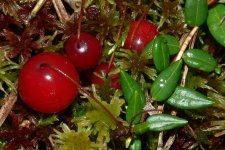cranberries ordinary - oxycoccus palustris pers.
Heather family - Ericaceae
The botanical characteristics. Creeping evergreen shrub. The leaves are small, dark green, ovate, with pointed tip, wrapped edges, with a glossy finish on the top and the bottom bluish bloom. Flowers axillary pink-red in racemes on stalks. The fruit - dark red berry. Blossoms in May - June. The fruits ripen in September - October.
Spread. It grows on moss bogs, maryah, wetlands, often forming zaroslevye carpets.
Used parts of the plant. Medical raw material is the entire plant, collected in the usual way during the entire growing season. The berries can be harvested in the fall and spring, which are well preserved in the snow due to high content benzoic acid.
Chemical composition. All parts of the plant contain phenolic compounds, arbutin; triterpenoids; ursolic acid; Flavonoids: giperin, quercetin; tannins, saponins. Fruits contain carbohydrates: glucose, sucrose, fructose, sorbitol, pectin; organic acids: quinine, ursolic, benzoic, malic, ascorbic, citric; essential oils, vitamins, phenol carbonic acids: chlorogenic; catechins, tannins, anthocyanins.
Application. Cranberries have long been used in medicine. It is part of the pharmacopoeia of domestic publications. It is used for hypertension, liver, kidney, pancreas, ascites, diathesis, fever, diseases of rheumatoid nature, as an antipyretic, with metabolic disorders, diseases of Addison.
All cranberry drugs have antiseptic, anti-inflammatory, hypotensive, anti-sclerotic, antiscorbutic effect, a positive effect on the water-salt metabolism, stimulate the activity of the pancreas, exhibit hemostatic effect. It is upsetting to Vibrio cholerae.
In Lithuania, the cranberries are used in the treatment of cancer, as a tonic, for sore throat, stomatitis, pharyngitis, enuresis as anthelmintic, to improve vision, especially - night, with hemorrhoids.
In folk medicine in many countries it is used in various diseases as berries have anti-microbial and diuretic properties, is used for the prevention and treatment of diseases of the kidneys, bladder and urinary tract.
Fresh juice from berries and extract increases the secretion of gastric and pancreatic juice in connection with this gipatsidnyh used to treat gastritis, pancreatitis in the initial stage of the disease.
In the experiment, the berries and juice extracts have antibacterial for Streptococcus, E. coli, Proteus, and treatment of purulent wounds as fungicide, cardiotonic, hypotensive agent.
In some countries in Europe and Asia cranberries considered anti-cancer agent.
All preparations cranberry effective in cosmetics as well as for removal of pigment stains. External used water infusions and decoctions, mainly flowers and leaves with women's diseases, eczema, glaucoma, ringworm.
Preparation. For infusion taking 15 g of flowers, pour 200 ml. boiled water, in a water bath for 15 minutes, cool 45 minutes, strain. Take 1/3 cup 2-3 times a day. The same infusion is used and the outer.
Contraindications. In the literature, there is evidence that the fresh juice and berries are contraindicated in gastric ulcer and 12 duodenal ulcer. In these cases should be used decoctions and infusions of flowers and leaves cranberries under the supervision of a physician.





Comments
Commenting, keep in mind that the content and the tone of your messages can hurt the feelings of real people, show respect and tolerance to his interlocutors, even if you do not share their opinion, your behavior in terms of freedom of speech and anonymity offered by the Internet, is changing not only virtual, but real world. All comments are hidden from the index, spam control.